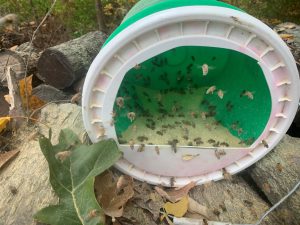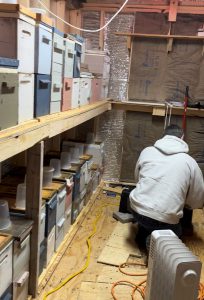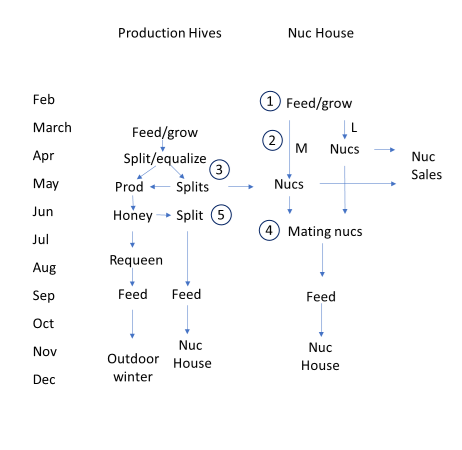By: James Masucci
In January, I wrote about two things I tried to help my bees overwinter (“Ready for Winter – Maybe” January Bee Culture, https://www.beeculture.com/ready-for-winter/). It’s time to review one of them, the European-style bee house used to overwinter my nucs. The bee house, which I am calling my nuc house, is partially insulated, heated with two space heaters, and was loaded with ~70 nucs ranging from two to six frames each. The circumstances at the time didn’t allow me to put much effort into this little experiment, so I threw what I had into the nuc house without any documentation. However, I have been able to observe colonies as Winter progressed and I’ve been able to determine that the nuc house is worth it for me. It’s not necessary, nor is it without problems, but it does help me solve one of my beekeeping dilemmas… how do I sell a lot of nucs without hurting my production hives?
Before I describe my strategy, there is an important albeit old, lesson in all of this… garbage in, garbage out. This should be no surprise to anybody. No facility, no matter how fancy, can make up for poor beekeeping. I went into the Winter season with about 70 nucs representing a range of quality. At the time of writing this, in mid-February, 54 nucs are still alive. Because it is a heated building with red lights, I feel comfortable peeking inside to evaluate the cluster size (yes, the bees still cluster even though it is warm inside). What I found was encouraging. Most of the colonies that died were tiny. Some were robbed out and some died as baseball-sized clusters that had no right going into Winter in the first place. Those still alive range from softball sized clusters to large, legitimate nucs. I anticipate some, but not all, of these smaller nucs may not make it either. Even though there may be little value in getting the small colonies through the Winter, (they will be too small for Spring build up) I believe these results highlight how the heated building makes it easier for colonies to overwinter by tempering the cold.

Picture 2: Outdoor feeding of pollen substitute to induce brood production can occur earlier with the nuc house since the heated building reduces the risk of chilled brood in late Winter / early Spring.
It’s this tempering that is the advantage of the nuc house! What happens if bees start brooding up too soon in the year? A cold snap hits and the bees have to choose between covering the brood or clustering. In the first case, they die. In the latter, they survive, but lose all their brood. A lot of resources went into that brood, resources needed to make the transition from overwintering to Spring build-up. Some colonies will never recover. Take away the danger of the cold snap and the risks of brooding up early become minimal. Because the nuc house is heated, I can entice these bees to brood up sooner (see picture 2), thus providing more bees in the Spring. More bees mean more opportunities.
I make money selling nucs and honey and generate my own queens for Summer requeening. I sell overwintered nucs that are delivered in mid-April and Spring nucs, derived from splits, that are delivered in mid-May. Everyone wants their bees early, so there is more demand for the overwintered nucs. The issue is that overwintered nucs come from strong, overwintered colonies where I remove the queen and five frames and recover the remaining bees with a purchased queen. The Spring nucs come from splits I do for swarm control. The demand for nucs is large, so I am constantly balancing how many nucs to sell vs how many hives remain for production. Throw in a high mortality Winter or the desire to expand my operation, and the honey harvest goes down because I don’t have enough production colonies. In addition, all the bees I need for queen rearing come from my production hives. With the nuc house, I no longer need to choose between honey and nucs.
I developed a strategy to eliminate the conflict between selling nucs and selling honey utilizing the nuc house. I’ve outlined the new strategy in Figure 1 where I manage two populations of bees. I eliminate the need to steal bees from my production hives to meet my nuc and queen demands. On the left side of the figure is the general scheme for my production hive management. Pollen starts coming in towards the end of February and I can start feeding in March. I do swarm management splits in April. I use those splits to fulfill any colony need in my production fleet. In addition, I use the large population of bees at the end of the honey flow to make mid-Summer splits which I grow into nucs for the nuc house. The number of production hives remains constant and focused on production until the honey flow is over. Only then are they used to build-up the nuc population.

Picture 1: Inside of the nuc house described in the January 2023 issue of Bee Culture. The insulated building is heated by two space heaters, which maintain it at 55°F. In very cold weather (-6°F), indoor temperatures are 30°F warmer. Each colony has its own entrance to the outside. The building allows for easy feeding and access to the hives.
On the right side of Figure 1 is the management of my nuc population. Because of the heated building, I can start feeding (syrup and protein, notice feeders in Picture 1 and pollen substitute bucket in Picture 2) a month sooner than the outdoor bees, giving them extra time to build up in the Spring. The larger nucs can be sold in mid-April, whereas the smaller, healthy nucs can build up an extra month and be sold in mid-May. The left-over bees from the nucs (there are always more than five frames of bees in the colonies), go towards mating nucs. These mating nucs are used to: 1. Provide bees for cell builders, 2. Draw out comb, 3. Mate queens. The number of nucs available for sale becomes dependent on the number of Summer splits I do. Something in MY control.

Figure 1: The nuc house allows me to separate my nuc business from my honey business. On the left is the general timeline for production hive management. On the right is the general timeline for nucs. The key advantages to this strategy are labeled 1-5.
1. The heated building reduces the risk of chilled brood, so I can induce brood rearing sooner.
2. The extra time gives smaller clusters (M) more time to build up, making them available for mid-May nuc sales.
3. With a healthy supply of overwintered nucs, I can focus my production hives on production, using splits to repopulate production yards.
4. Extra bees from making nucs go into mating nucs, which eliminates the need to use
production hives to source my queen rearing needs.
5. Mid-Summer splits are used to grow a healthy population of nucs to overwinter.
M = medium-size nucs. L = large-size nucs.
The strategy I just described is not dependent on a heated nuc house. Strong nucs will survive outside. I have done it. One could easily substitute a nuc yard for the nuc house in Figure 1. There is an argument that having the colonies separated is the better option due to drifting, disease spread and robbing. Plus, there is the cost of both building and heating the nuc house. But there are several advantages to the nuc house. The biggest is the early Spring build up. An extra month is a big advantage. Mid-Summer splits don’t always grow as fast as I want them so the nucs may not be as large as I want them going into Winter. Having all the nucs in a heated building, conveniently located next to my honey house where I visit often and have the capacity to make up syrup, means that I can baby them through the Winter resulting in fewer losses and more bees to start the Spring build-up. In the end, I am glad I did it. I will make some improvements to the bee house (like more insulation) and implement my new strategy. Hopefully, you will hear how I reached both my honey production goals AND my nuc sale goals.






